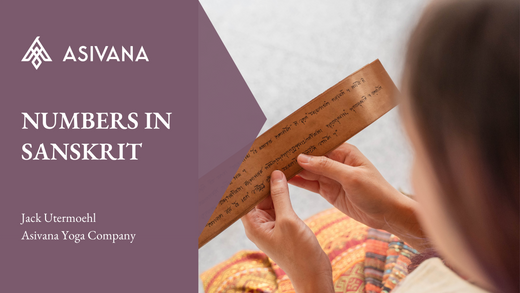
Numbers in Sanskrit for Sun Salutations
Jack UtermoehlShare
Numbers hold special significance in Sanskrit, one of the world's oldest languages. Each digit carries unique meanings and is associated with symbolic concepts in spiritual practices. By understanding these numbers, practitioners can deepen their connection with traditional yoga practices.
Interested in more numbers in Sanskrit? Read: 108 Sanskrit Numbers
On top of being able to count numbers in Sanskrit, you can even count the Sun Salutation sequences out in Sanskrit. This will be especially interesting for yoga teachers.
Surya Namaskar Numbers in Sanskrit
Surya Namaskar, or Sun Salutation, originated from the Vedic traditions of India. The practice was later adapted into Hatha yoga by 20th-century yoga practitioners. It evolved to be part of ashtanga yoga, vinyasa yoga, and many other types of yoga becoming a staple in yoga classes for its ability to prepare the body and mind for further asana (posture) practice.
There are two sequences for Surya Namaskar that we can use numbers in Sanskrit to count.
Understanding the count of these sequences in Sanskrit introduces a unique layer of meaning and connection for practitioners.

Understanding Sanskrit Numbers (1-18)
To appreciate the significance of numbers in yoga, it's important to understand how they sound and what they represent. Here is a list of Sanskrit numbers from 1 to 18:
1) एक (Ekam) - Pronounced eh-kam, it means "one,"
2) द्वि (Dve) - Pronounced dvay, meaning "two,"
3) त्रि (Trini) - Pronounced tri-nee, represents "three,"
4) चतुर (Catvari) - Pronounced chut-var-ree, meaning "four,"
5) पञ्च (Panca) - Pronounced pun-cha, it means "five,"
6) षष्ठ (Sat) - Pronounced saht, means "six,"
7) सप्त (Sapta) - Pronounced sup-tah, meaning "seven,"
8) अष्ट (Astau) - Pronounced ash-tauh, means "eight,"
9) नव (Nava) - Pronounced nuh-vah, meaning "nine,"
10) दश (Dasa) - Pronounced duh-sha, represents "ten,"
From 11 to 18, the numbers continue as compound forms, each adding the suffix "dasa" to the previous numerals:
11) एकादश (Ekadasha) - Pronounced eh-kah-dah-shah, "eleven"
12) द्वादश (Dvadasha) - Pronounced dvaa-dah-shah, "twelve"
13) त्रयोदश (Trayodasha) - Pronounced try-oh-dah-shah, "thirteen"
14) चतुर्दश (Caturdasa) - Pronounced cha-toor-dah-shah, "fourteen"
15) पञ्चदश (Pancadasa) - Pronounced pun-cha-dah-shah, "fifteen"
16) षोडश (Sodasa) - Pronounced sho-dah-shah, "sixteen"
17) सप्तदश (Saptadasa) - Pronounced sup-ta-dah-shah, "seventeen"
18) अष्टादश (Astadasa) - Pronounced ush-ta-dah-shah, "eighteen"

Connecting Numbers in Sanskrit to Surya Namaskar A
In Surya Namaskar A, a 10-count sequence of poses seamlessly connects breath and movement. This is not a detailed description of how to do Surya Namaskar A. It's a detailed description of the numbers in Sanskrit. Here is a detailed look at the numbers in Sanskrit for Sun Salutation A.
1) Ekam - Tadasana (Mountain Pose)
2) Dve - Urdhva Hastasana (Upward Salute)
3) Trini - Uttanasana (Standing Forward Bend)
4) Catvar - Ardha Uttanasana (Half Forward Bend)
5) Panca - Chaturanga Dandasana (Four-Limbed Staff Pose)
6) Sat - Urdhva Mukha Svanasana (Upward-Facing Dog)
7) Sapta - Adho Mukha Svanasana (Downward-Facing Dog)
8) Astau - Ardha Uttanasana (Half Forward Bend)
9) Nava - Uttanasana (Standing Forward Bend)
10) Dasa - Urdhva Hastasana (Upward Salute)

Connecting Numbers in Sanskrit to Surya Namaskar B
Surya Namaskar B expands the flow of the practice, integrating additional poses. Here is the 18-count sequence of Surya Namaskar B, with each pose linked to its Sanskrit number:
1) Ekam - Tadasana (Mountain Pose)
2) Dve - Utkatasana (Chair Pose)
3) Trini - Uttanasana (Standing Forward Bend)
4) Chatvari - Ardha Uttanasana (Half Forward Bend)
5) Panca - Chaturanga Dandasana (Four-Limbed Staff Pose)
6) Sat - Urdhva Mukha Svanasana (Upward-Facing Dog)
7) Sapta - Adho Mukha Svanasana (Downward-Facing Dog)
8) Astau - Virabhadrasana I (Warrior I Pose) - Right
9) Nava - Chaturanga Dandasana (Four-Limbed Staff Pose)
10) Dasa - Urdhva Mukha Svanasana (Upward-Facing Dog)
11) Ekadasa - Adho Mukha Svanasana (Downward-Facing Dog)
12) Dvadasa - Virabhadrasana I (Warrior I Pose) - Left
13) Trayodasha - Chaturanga Dandasana (Four-Limbed Staff Pose)
14) Chaturdasa - Urdhva Mukha Svanasana (Upward-Facing Dog)
15) Panchadasa - Adho Mukha Svanasana (Downward-Facing Dog)
16) Shodasa - Ardha Uttanasana (Half Forward Bend)
17) Saptadasa - Uttanasana (Standing Forward Bend)
18) Astadasa - Utkatasana (Chair Pose)

The Significance of Counting in Practice
Counting numbers in Sanskrit plays a pivotal role in maintaining the rhythm and mindfulness of a yoga practice. A consistent count helps synchronize the breath and movement with each posture. This synchronization allows practitioners to enter a meditative flow.
Integrating Sanskrit counting into your practice or classes deepens this experience. Each Sanskrit number carries its own vibrational quality, which can influence the energy of the practice.
By chanting the numbers in Sanskrit, practitioners connect with the roots of yoga.
Integrating Numbers in Sanskrit to Your Practice
The relationship between Sanskrit numbers and Surya Namaskar is deeply intertwined. As we explore the Sun Salutation sequences, counting each pose in Sanskrit reinforces the spiritual aspect of the practice.
Integrating Sanskrit counting can transform the practice, adding layers of mental and physical significance.
I encourage you to integrate Sanskrit counting into your practice or teachings, whether through silent repetition or chanting aloud to your class as they flow through Surya Namaskar.
Please feel free to share in the comments below how integrating numbers in Sanskrit has influenced your practice.











2 comments
Namastha very informative and helps to mother and child startup little yogis
I had no idea you could count the sun salutation sequence in numbers!
18 count + 6 sun salutations = 108